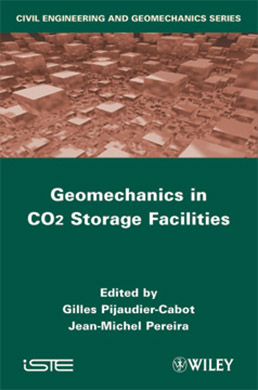
CO2 capture and geological storage is seen as the most effective technology to rapidly reduce the emission of greenhouse gases into the atmosphere. Up until now and before proceeding to an industrial development of this technology, laboratory research has been conducted for several years and pilot projects have been launched. So far, these studies have mainly focused on transport and geochemical issues and few studies have been dedicated to the geomechanical issues in CO2 storage facilities. The purpose of this book is to give an overview of the multiphysics processes occurring in CO2 storage facilities, with particular attention given to coupled geomechanical problems.
The book is divided into three parts. The first part is dedicated to transport processes and focuses on the efficiency of the storage complex and the evaluation of possible leakage paths. The second part deals with issues related to reservoir injectivity and the presence of fractures and occurrence of damage. The final part of the book concerns the serviceability and ageing of the geomaterials whose poromechanical properties may be altered by contact with the injected reactive fluid.
Part 1. Transport Processes
1. Assessing Seal Rock Integrity for CO2 Geological Storage Purposes, Daniel Broseta.
2. Gas Migration through Clay Barriers in the Context of Radioactive Waste Disposal: Numerical Modeling of an InSitu Gas Injection Test, Pierre Gerard, Jean-Pol Radu, Jean Talandier, Rémi de La Vaissière, Robert Charlier and Frédéric Collin.
3. Upscaling Permeation Properties in Porous Materials from Pore Size Distributions, Fadi Khaddour, David Grégoire and Gilles Pijaudier-Cabot.
Part 2. Fracture, Deformation and Coupled Effects
4. A Non-Local Damage Model for Heterogeneous Rocks – Application to Rock Fracturing Evaluation Under Gas Injection Conditions, Darius M. Seyedi, Nicolas Guy, Serigne Sy, Sylvie Granet and François Hild.
5. Caprock Breach: A Potential Threat to Secure Geologic Sequestration of CO2, A.P.S. Selvadurai.
6. Shear Behavior Evolution of a Fault due to Chemical Degradation of Roughness: Application to the Geological Storage of CO2, Olivier Nouailletas, Céline Perlot, Christian La Borderie, Baptiste Rousseau and Gérard Ballivy.
7. CO2 Storage in Coal Seams: Coupling Surface Adsorption and Strain, Saeid Nikoosokhan, Laurent Brochard, Matthieu Vandamme, Patrick Dangla, Roland J.-M. Pellenq, Brice Lecampion and Teddy Fen-Chong.
Part 3. Aging and Integrity
8. Modeling by Homogenization of the Long-Term Rock Dissolution and Geomechanical Effects, Jolanta Lewandowska.
9. Chemoplastic Modeling of Petroleum Cement Paste under Coupled Conditions, J.F. Shao, Y. Jia, N. Burlion, J. Saint-Marc and A. Garnier.
10. Reactive Transport Modeling of CO2 Through Cementitious Materials Under Supercritical Boundary Conditions, Jiyun Shen, Patrick Dangla and Mickaël Thiery.
11. Chemo-Poromechanical Study of Wellbore Cement Integrity, Jean-Michel Pereira and Valérie Vallin.
Gilles Pijaudier-Cabot is Professor of Civil Engineering at the University of Pau and Pays de l’Adour, France. His main research interests concern damage and fracture of cementitious materials, failure analysis and strain localization, non-local modeling and localization limiters, durability mechanics of concrete structures (experimental and computational), and coupled problems in geomechanics.
Jean-Michel Pereira is a Research Scientist at Laboratoire Navier, École Nationale des Ponts et Chaussées, Marne-la-Vallée, France. His research focuses on the experimental and theoretical study of multiphysics couplings in geomaterials (soils, rocks, cementitious materials) and applies mainly to energy and environmental issues.